The Six Best Spanish Learning Resources — Free and Paid
There are a lot of Spanish learning resources lists out there — but we’ve tried to cut through the chaff and just give you the best and only ones you need.
We learned Spanish 20 years ago, using books and cassette tapes (in my case), and class notes (in Jo’s case).
People often ask us
- What would you use to learn Spanish again today?
- What are the best Spanish language learning apps — if any?
- Where do you find a good Spanish teacher online?
So those are all the questions we’re trying to answer.
Whether we’re travelling or not, studying a language from home is one of the most fun things we do, so we’re happy to share our m.o.
And the reason that this is the best possible list on the internet is that this is only the best websites, books, apps, and tools to learn Spanish even if they don’t earn us a dime.
Hope you enjoy it!

Become a Discoverer
Like this BS-free guide to how to learn Spanish? Join our email list of thousands of people discovering the world around them via language, culture, and travel.
Contents
Why we’re different — What an “Honest” Spanish learning resources list means
There are seemingly mostly four kinds of language-learning resources lists on the Internet:
- Apps promoting their own product
- Blogs promoting (or highly prioritising) only products they get a commission from
- Mega lists of every resource out there, including bad ones, even including broken links
- Terrible partial lists you can ignore
Basically even when you’re on the hunt for something good, there’s a lot of noise to cut through.
I want to change that with an honest, no-BS list of Spanish learning resources I’d actually recommend even if I get no commission from them (and in most cases, I don’t).
Google “best Spanish resources” and you’ll find links to things like Duolingo, 101 Languages, Rosetta Stone, Rocket Languages and so on.
Some of those are OK. But by no means are they all the best. I personally don’t even think Rosetta Stone or 101 Languages resources ever belong in a list of the “best” Spanish Resources. So that’s the last you’ll hear of them here.
You don’t need much to learn a language. You need a book, flashcards, something to listen to/watch, and a teacher. The rest is just time and doing the homework you’ll definitely get from your teacher!
I specifically am ignoring products that I could earn a huge commission from because I don’t recommend those products.
OK that aside, now about me as a language learner so you know who’s making this list.
About us as Spanish Learners
I learned Spanish a long, long time ago — in 1999/2000, while working abroad in the Middle East, and later, in a town called Valladolid, in the Castilla y León province in Spain.

I decided to learn Spanish as it seemed like a good first language to learn. It grants you access to hundreds of millions of people and many countries (and potentially women… hey, I was very young! And I’m still male/hetero!) so… I decided to learn Spanish.
I bought some cassette tapes online. I started doing exercises in books, and then I found some people who spoke Spanish from countries including Bolivia, Spain, and Costa Rica, and sat down and talked to them.
I met tourists and chatted with them and even spoke Spanish to the Sephardic Jews, many of whom had learned Spanish as part of their complicated cultural heritage (see here for a breakdown of the cultural/ethnic groups of the region).
But things have changed from the time I needed to use language cassette tapes and Teach Yourself Spanish.
We often travel to Spanish-speaking countries. We just left Colombia right now, and while I was there I got used to the Caleño and then the Paisa accents ane learned quite a bit of Colombian slang.
But I wanted to answer the question: If I were to learn Spanish again, from scratch, TODAY, what resources would I use?
Here’s my answer to that question. No gimmicks, no high-commission garbage — just the facts.
You might also like these other posts about Spanish…
General Approach — How to Learn Spanish
The first thing I want to answer is — if you want to go to a Spanish-speaking country, learn Spanish before you go.
At LEAST learn about 1000 words and how to form most basic sentences. You don’t need to master the subjunctive mood and weird expressions and slang, but know the basics.
Assuming you’re an English speaker or at least fluent in English, there are three parts of Spanish you have to master: pronunciation, vocabulary, and grammar.
Here’s how I suggest dividing up your effort between these vocabulary, pronunciation, and grammar:
| Language part | Effort | What to do |
|---|---|---|
| Vocabulary | 30% | You need to spend time memorising vocabulary — get fluent in the most basic, everyday words. Luckily after 1,000 or so words, your “advanced” vocabulary is easier. |
| Pronunciation | 10% | Get it right, and learn it early. Trill your Rs, practise the rhythm of the language and the natural tone — then move on and practise. |
| Grammar | 60% | Focus on here from the beginning. Learn grammatical gender. Learn all the conjugations of verbs. Learn how to build sentences and practise them. This is the key to fluency! |
Here’s what I’d do to get myself to the first 1000 words — if I were starting again today (ah, the benefit of hindsight).
First, learn Spanish pronunciation. Learn how to read Spanish even if you don’t understand it. It’s VERY easy. It’s mostly phonetic.
You can learn what the accents mean, too. If you can’t trill your Rs (it’s slightly different to trilled Rs in any other language, but you’ll at least have a head-start if you speak Italian, Farsi, or something similar), practise this until it sounds roughly right.
Say quiero comer arepas con carne alrededor de las tres until you sound natural!
Second, start building simple sentences and vocabulary — and learn the rules for grammatical gender.
Spanish has two genders for nouns, masculine and feminine. A few rules make it easier, e.g.
- Words ending with -o are generally masculine — e.g. el zapato, el frigorífero, el baño
- Words ending with -a are generally feminine — e.g. la mesa, la cebolla, la guitarra
- Words ending with -ion are generally feminine — e.g. la nación, la plantación, la convención
- Words ending with -dad are generally feminine — e.g. la ciudad, la nacionalidad, la libertad
- Words ending with -aje are generally masculinee, e.g. el paisaje, el equipaje, el salvaje
And so on. Learn the rules for “guessing” grammatical gender and it’ll make your life MUCH easier.
Finally, learn all the verb conjugations.
Bad news — Spanish has a ton of conjugations. But there’s actually no way around learning them.
There are three main categories of verbs: those that end in -ar, those that end in -er, and those that end in -ir. Anecdotally it feels like 40%/40%/20% between them all respectively.
Within those categories of verbs, conjugation is mostly consistent with relatively few exceptions.
But there are many verbs that are totally exceptions, and unfortunately, those exceptions are the most common verbs (like to want, to have, to hold, etc.).
For every verb, you have to learn (example below is for hablar, “to speak”) these conjugations:
- Present: hablo, hablas, habla etc.
- Simple past: hablé, hablaste, hablamos
- Perfect: hablado (combined with haber)
- Continuous past: hablaba, hablabas, hablaban
- Continous tense: hablando (combined with estar)
- Present subjunctive: hable, hables, hablen
- Past subjunctive: hablara, hablara, hablaran
- Conditional: hablaría, hablarías, hablaríamos
- Future: hablaré, hablarás, hablarámos
You have to know how to do these conjugations for every verb.
Bonus: Spend extra time on the subjunctive. Most foreigners I meet who speak French or Spanish seem to never really try hard with the subjunctive, and just work around it.
But the best speakers use the subjunctive, and you can tell — it adds a touch of fluency to their conversation that makes people think “Ahh, this person speaks Spanish really well! Si no supiera que es extranjera, jamás lo habría adivinado!” (There’s a little subjunctive example for you there.)
OK, now you know how to learn Spanish. So what resources should you use?
Get a good book — We recommend Teach Yourself or Colloquial books
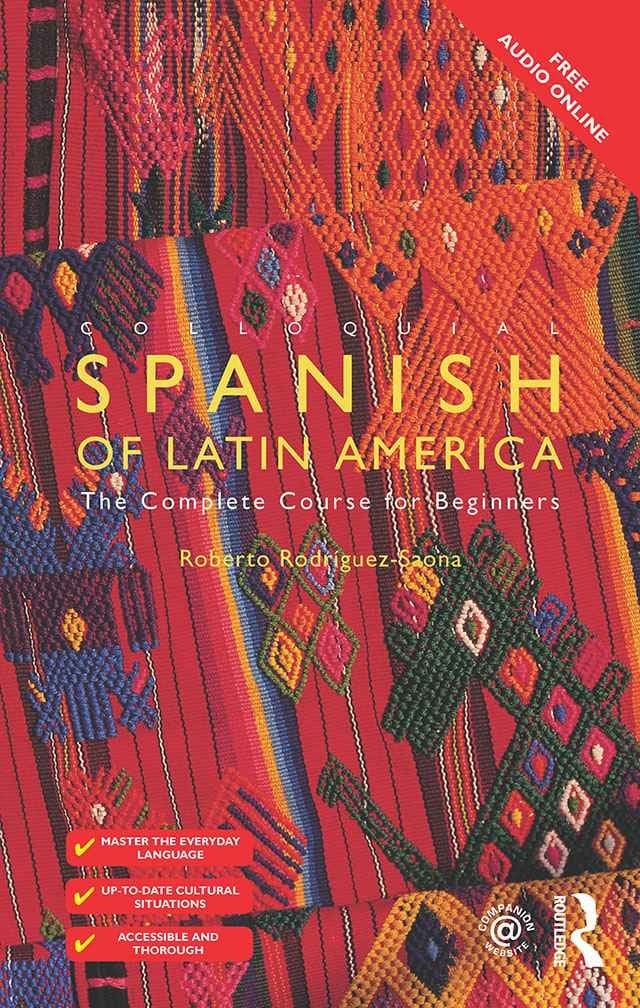
These are the textbooks I used ages ago, and I’d still use them! We always recommend starting with a book, and so a book is the first of our Spanish learning resources.
It’s boring advice, so nobody gives it, especially because it earns very little for bloggers.
Spanish language-learning books follow a fairly predictable path of taking you through a range of dialogues and teaching you grammar along the way. Because the grammar and writing system isn’t overwhelmingly complicated (like Japanese or Korean), you don’t need to spend a while just understanding the basic rules first, and can dive into learning conversation.
What’s really important is that you do the exercises. I know, these are boring! But seriously, you expose how much you haven’t learned very quickly.
In fact, doing grammar exercises is so important I’d pick up any other textbook that’s just grammar and exercises and hammer those words in until you know them and can conjugate them every single way.
Once you’ve worked your way through at least one book and listened to the dialogues, you can move on to something more comprehensive like an online course.
Use the Best Spanish Dictionary — WordReference
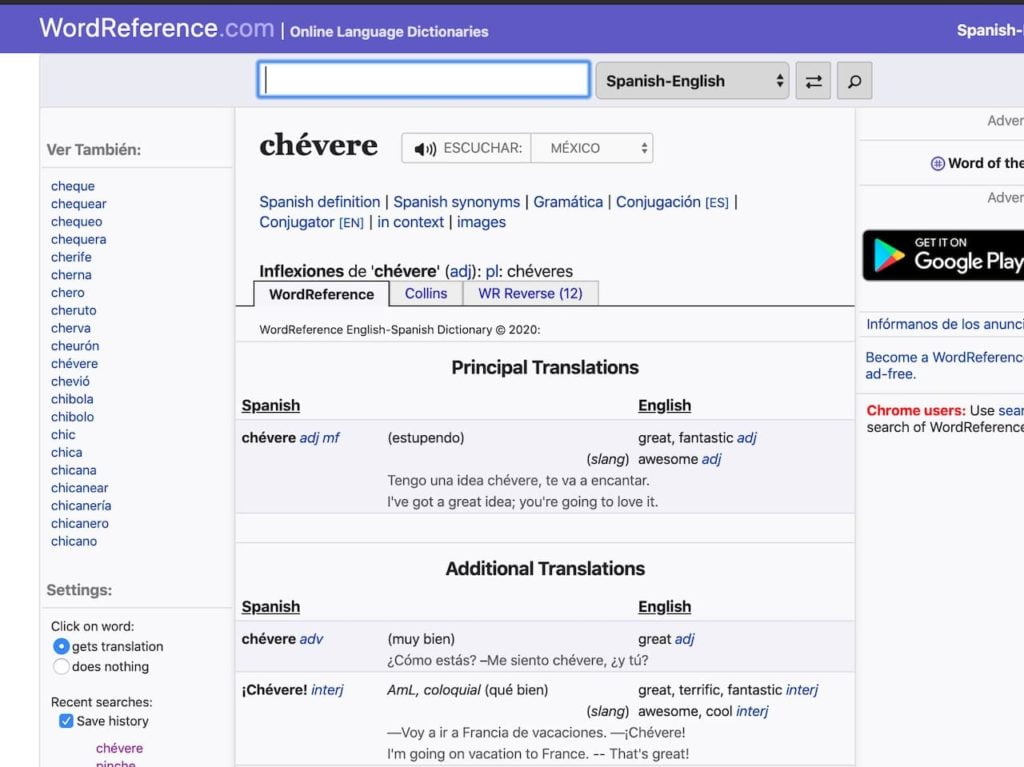
WordReference has been the best online language dictionary for most languages for many years.
It has every word, plus discussion forums where people discuss colloquial phrases, and many, many sentence examples.
It’s great for most languages, but it’s especially great for very popular languages to learn like Spanish and French.
In my day, I used a big fat Collins paper dictionary which also had examples. But in modern times, WordReference is definitely king.
Listen to LanguageTransfer’s Free Spanish Podcast series
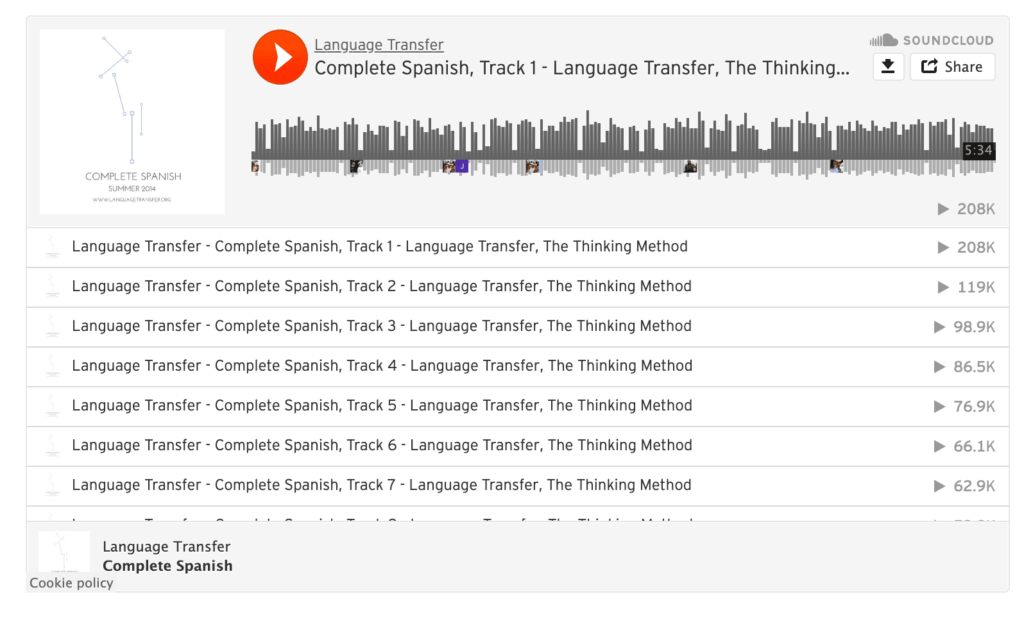
Language Transfer is a “Michel Thomas”-style podcast (without some of the annoying bits like over-verbosity or using an unnecessary second-student) where they explain the way Spanish works in a way that’s really intuitive for English speakers.
This is an English-language podcast. You mostly listen to someone speaking English explaining Spanish and how to “think” in it. They don’t just teach you words and phrases but really how to bend your mind into a Spanish-speaking mindset.
They have a bunch of other languages too, but the Spanish one is really recommended.
Oh yeah, and it’s free!
Sign up to an online course: Rocket Spanish OR Assimil Spanish
These two online courses are great Spanish learning resources. You can pick the one you want and ignore all the others.
We’re recommending them even though we don’t get a dime for it. Here’s a link for Rocket Spanish — which doesn’t earn us a cent! And here’s a link for Assimil (you can’t earn money from Assimil).
We’ve used Rocket for Arabic and Korean, but it’s very well recommended for Spanish as well (and to my eye, the content is great and it all looks the same).
Rocket Spanish is like a next-level textbook. Because it’s online, I personally think it’s not an ideal place to start — something about the fact that it’s on a computer means it’s very easy to switch between tabs and get distracted.
But still, Rocket is a very comprehensive course and one of the best Spanish learning resources out there.
Here’s what we liked about it:
- Loads of sample sentences
- Very clear audio, recorded by native speakers
- You can download the entire course offline (unlike Glossika which has zero offline support)
- It comes with a good app
The pricing is decent, too. Don’t over-commit — get the base version for $99 and work your way through that. They have a 60-day money-back guarantee if you’re not sure. We’ve tested the guarantee and it works!
Note that the style of Rocket Arabic is a generic “Latin American” style of pronunciation. This means that if you go speaking that style in Spain, you won’t ever sound quite local. But everywhere else, you’ll be a lot closer!
Assimil Spanish is one of the few online courses that Assimil produces in English (Assimil is mostly a French-language company).
Note that Assimil produces many old-school books and tapes. Those are also well-liked by the language-learning community. But this is specifically about their new-ish online course you get.
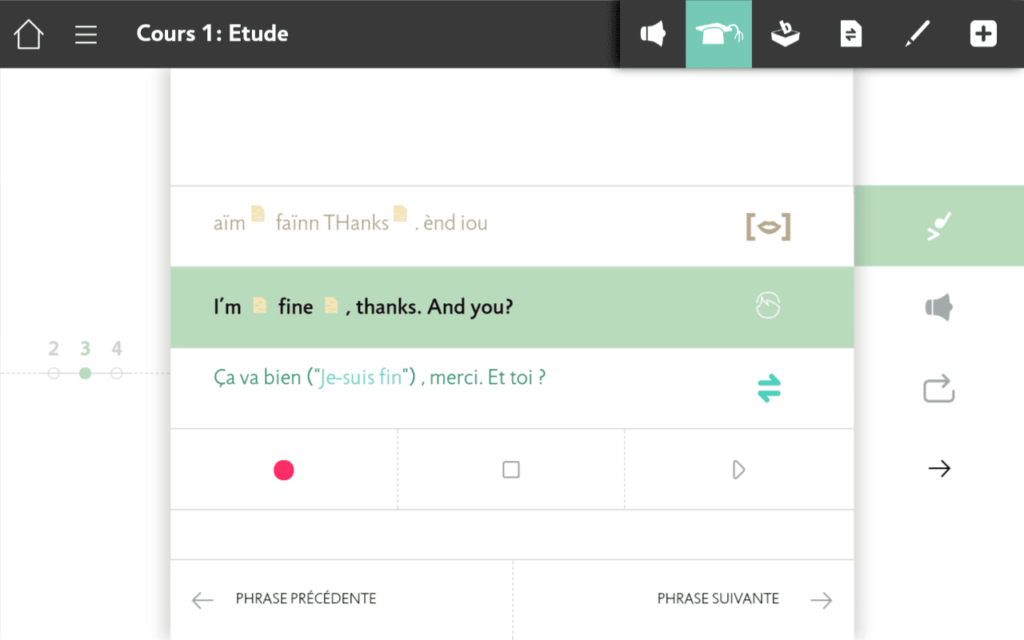
Get an online Spanish tutor on iTalki
You’d think we work for italki, but we don’t. We just really love doing language lessons in our living room for less than we pay for the privilege of going somewhere in person.
Get $5 in italki credits — enough for a trial class!
Get a tutor online for as little as $4/lesson from italki with $5 in credits after your first purchase of $20 of credits.
I have so many annoying memories (in the past) of getting dressed and ready and then getting a taxi and subway for 45 minutes to get to a tutor that I didn’t even necessarily love.
italki is the opposite. I like all my teachers, I don’t have to go anywhere, and they’re CHEAP!
The italki experience isn’t perfect. It’s a few too many clicks, and sometimes I get annoyed with the payment process.
Even though I didn’t use italki to learn Spanish, I did use it to take a few lessons in local Spanish slang and accents and the experience was the same as for any other language — cheap, high-quality, and very convenient.
Also, there’s a lack of a feeling of continuity when I work online with a teacher. You have to either have your own curriculum or work off a textbook together. Otherwise, you can stagnate, or run out of things to say.
My best teacher ever still was an in-person teacher. But he cost $30 an hour (in China! That’s like $60 an hour in America), and he was about the 10th teacher I tried — it took a long time to find the right one.
In summary, look, I always wear pants for italki lessons I do via videoconference. But it’s kind of cool knowing I don’t have to… (but I won’t take the risk!)
Use Flashcards to drill in words — Anki

Anki is a free flashcard system.
There are lots of good flashcard systems out there — actually an infinite number of tiny apps you can find on the App Store or Google Play, but Anki is the gold standard.
The interface to Anki is slightly clunky. This is typical of free software. But it’s worth it because
- Anki is extremely popular among language-learners (plus many other learners… med students love it)
- There are lots of free decks you can go find (plus some you can pay for… and which cost almost nothing)
- It’s very feature-rich — I’m still finding new features years after starting to use it.
One of my favourite points of the above are the free decks. It’s amazing what free stuff there is out there! Here are the two best Anki Spanish decks:
- Sentences — this list of 1001 sentences sorted from easiest to hardest with audio
- Words — this list of 5,000 Spanish words with audio and images
These decks are FREE. They might also contain the occasional error, but in my experience, every resource has errors (even paid ones).
Anki itself is also free on the desktop. The Android version is free, but you pay for the iOS version (which you should, fancy Apple phone owners! j/k I used to be one of you).
Here’s a guide to getting started with Anki we put together.
What I don’t recommend for learning Spanish
I want to make a special note of apps that I haven’t recommended for learning Spanish.
None of these Spanish learning resources below are “bad”, but they shoudln’t be used extensively (or exclusively).
I’ve tried them all — in Spanish, and in other languages — so this is my honest experience.
- Duolingo. This is a game. Again, there’s nothing wrong with it, and you’ll learn words and have fun. It might be a good way to spend random five-minute blocks. But don’t be sucked into the false productivity trap of apps where you think you can click your way to fluency — “click your way to fluency” sounds weird because it’s not true.
- Rosetta stone. Overpriced. A fun visual aid. Again, you’ll learn some words and phrases, and there’s nothing wrong with opening it up every now and then… but for what specific purpose, I don’t know. But it won’t get you to fluency by itself.
- SpanishPod101. I’ve always thought these podcasts were a big waste of time.




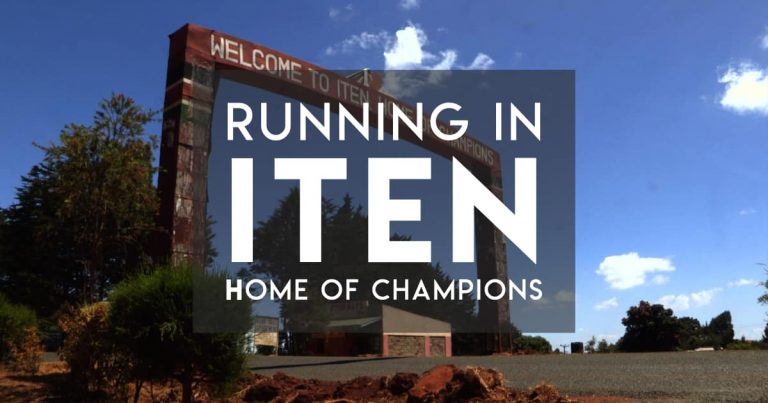
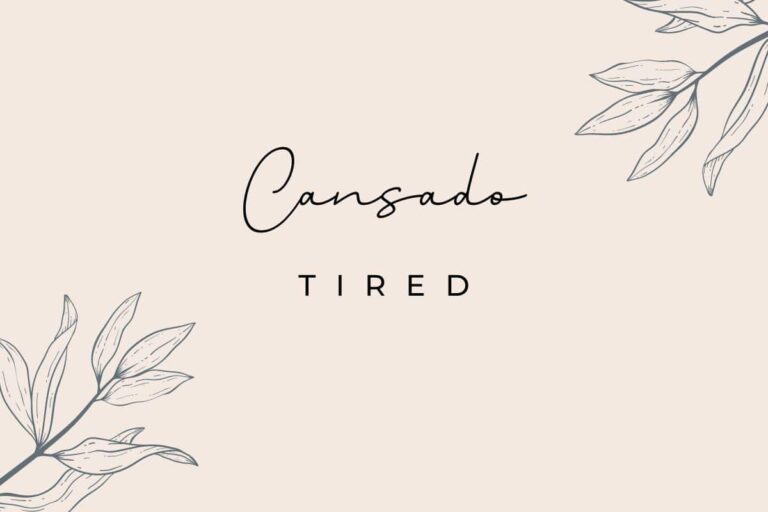

I’m planning to start learning Spanish to help me better communicate with my Spanish patients and because I know it will make my girlfriend (Spanish is her first language) incredibly happy. I love how thorough and useful this has been to help me come up with a plan on where to start. I have some background as I took Spanish in high school but that was over 16 years ago lol, and will be able to get a lot of practice with my girlfriend so hopefully can make fast progress. I do have one question though, I was initially planning… Read more »
Firstly, I have to update that article to add Glossika/Speechling! Secondly, before using either of those, I’d really just buy a book to refresh the basics of the grammar. I know you learned it ages ago, but you’ve probably forgotten a few of the many simple rules that might help you (e.g. how to guess the gender of certain types of nouns, for a random example). I find it hard to “skim” a website (mostly as I get distracted), but if you don’t, then Rocket would undoubtedly have the same content. Hold on to a course/book because you’ll need to… Read more »